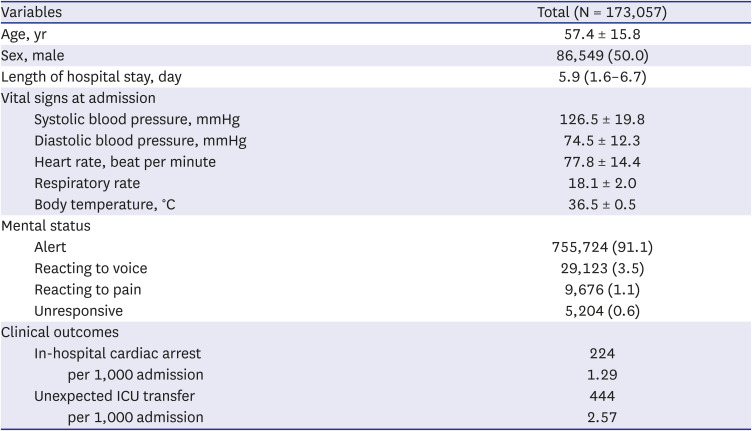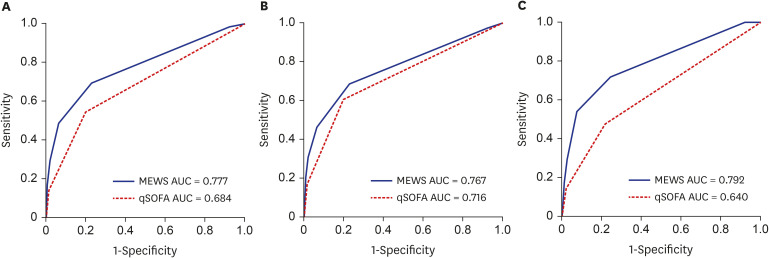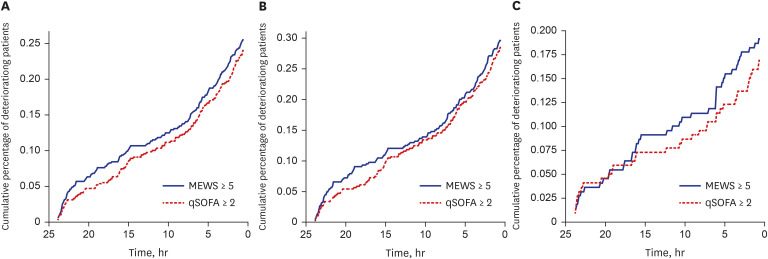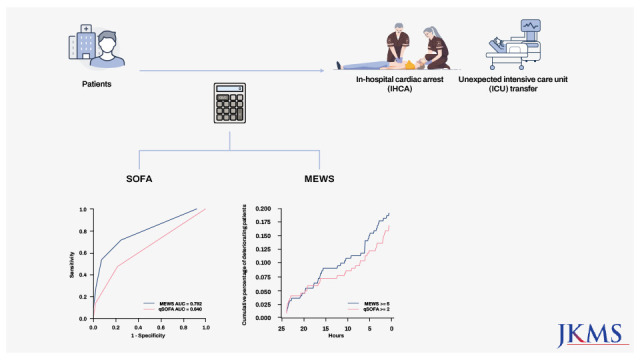1. Churpek MM, Yuen TC, Winslow C, Robicsek AA, Meltzer DO, Gibbons RD, et al. Multicenter development and validation of a risk stratification tool for ward patients. Am J Respir Crit Care Med. 2014; 190(6):649–655. PMID:
25089847.
2. Escobar GJ, LaGuardia JC, Turk BJ, Ragins A, Kipnis P, Draper D. Early detection of impending physiologic deterioration among patients who are not in intensive care: development of predictive models using data from an automated electronic medical record. J Hosp Med. 2012; 7(5):388–395. PMID:
22447632.
3. Kause J, Smith G, Prytherch D, Parr M, Flabouris A, Hillman K, et al. A comparison of antecedents to cardiac arrests, deaths and emergency intensive care admissions in Australia and New Zealand, and the United Kingdom--the ACADEMIA study. Resuscitation. 2004; 62(3):275–282. PMID:
15325446.
4. Churpek MM, Yuen TC, Edelson DP. Risk stratification of hospitalized patients on the wards. Chest. 2013; 143(6):1758–1765. PMID:
23732586.
5. Umscheid CA, Betesh J, VanZandbergen C, Hanish A, Tait G, Mikkelsen ME, et al. Development, implementation, and impact of an automated early warning and response system for sepsis. J Hosp Med. 2015; 10(1):26–31. PMID:
25263548.
6. Subbe CP, Kruger M, Rutherford P, Gemmel L. Validation of a Modified Early Warning Score in medical admissions. QJM. 2001; 94(10):521–526. PMID:
11588210.
7. Liu V, Escobar GJ, Greene JD, Soule J, Whippy A, Angus DC, et al. Hospital deaths in patients with sepsis from 2 independent cohorts. JAMA. 2014; 312(1):90–92. PMID:
24838355.
8. Seymour CW, Liu VX, Iwashyna TJ, Brunkhorst FM, Rea TD, Scherag A, et al. Assessment of clinical criteria for sepsis: for the Third International Consensus Definitions for Sepsis and Septic Shock (Sepsis-3). JAMA. 2016; 315(8):762–774. PMID:
26903335.
9. Levy MM, Evans LE, Rhodes A. The Surviving Sepsis Campaign bundle: 2018 update. Crit Care Med. 2018; 46(6):997–1000. PMID:
29767636.
10. Rhodes A, Evans LE, Alhazzani W, Levy MM, Antonelli M, Ferrer R, et al. Surviving Sepsis Campaign: international guidelines for management of sepsis and septic shock: 2016. Intensive Care Med. 2017; 43(3):304–377. PMID:
28101605.
11. Smith GB, Prytherch DR, Schmidt PE, Featherstone PI. Review and performance evaluation of aggregate weighted ‘track and trigger’ systems. Resuscitation. 2008; 77(2):170–179. PMID:
18249483.
12. Smith ME, Chiovaro JC, O’Neil M, Kansagara D, Quiñones AR, Freeman M, et al. Early warning system scores for clinical deterioration in hospitalized patients: a systematic review. Ann Am Thorac Soc. 2014; 11(9):1454–1465. PMID:
25296111.
13. Evans L, Rhodes A, Alhazzani W, Antonelli M, Coopersmith CM, French C, et al. Surviving Sepsis Campaign: international guidelines for management of sepsis and septic shock 2021. Crit Care Med. 2021; 49(11):e1063–e1143. PMID:
34605781.
14. Churpek MM, Snyder A, Han X, Sokol S, Pettit N, Howell MD, et al. Quick sepsis-related organ failure assessment, Systemic Inflammatory Response Syndrome, and Early Warning Scores for detecting clinical deterioration in infected patients outside the intensive care unit. Am J Respir Crit Care Med. 2017; 195(7):906–911. PMID:
27649072.
15. Churpek MM, Snyder A, Sokol S, Pettit NN, Edelson DP. Investigating the impact of different suspicion of infection criteria on the accuracy of quick sepsis-related organ failure assessment, Systemic Inflammatory Response Syndrome, and Early Warning Scores. Crit Care Med. 2017; 45(11):1805–1812. PMID:
28737573.
16. American College of Surgeons. Advanced Trauma Life Support Course for Physicians. Chicago, IL, USA: American College of Surgeons;1989.
17. Kelly CA, Upex A, Bateman DN. Comparison of consciousness level assessment in the poisoned patient using the alert/verbal/painful/unresponsive scale and the Glasgow Coma Scale. Ann Emerg Med. 2004; 44(2):108–113. PMID:
15278081.
18. Redfern OC, Smith GB, Prytherch DR, Meredith P, Inada-Kim M, Schmidt PE. A comparison of the quick sequential (sepsis-related) organ failure assessment score and the National Early Warning Score in non-ICU patients with/without infection. Crit Care Med. 2018; 46(12):1923–1933. PMID:
30130262.
19. Lo RS, Leung LY, Brabrand M, Yeung CY, Chan SY, Lam CC, et al. qSOFA is a poor predictor of short-term mortality in all patients: a systematic review of 410,000 patients. J Clin Med. 2019; 8(1):E61. PMID:
30626160.
20. Hillman K, Chen J, Cretikos M, Bellomo R, Brown D, Doig G, et al. Introduction of the medical emergency team (MET) system: a cluster-randomised controlled trial. Lancet. 2005; 365(9477):2091–2097. PMID:
15964445.
21. Song JU, Suh GY, Park HY, Lim SY, Han SG, Kang YR, et al. Early intervention on the outcomes in critically ill cancer patients admitted to intensive care units. Intensive Care Med. 2012; 38(9):1505–1513. PMID:
22592633.
22. Hanley JA, McNeil BJ. The meaning and use of the area under a receiver operating characteristic (ROC) curve. Radiology. 1982; 143(1):29–36. PMID:
7063747.
23. Pencina MJ, D’Agostino RB Sr, D’Agostino RB Jr, Vasan RS. Evaluating the added predictive ability of a new marker: from area under the ROC curve to reclassification and beyond. Stat Med. 2008; 27(2):157–172. PMID:
17569110.
24. Churpek MM, Yuen TC, Huber MT, Park SY, Hall JB, Edelson DP. Predicting cardiac arrest on the wards: a nested case-control study. Chest. 2012; 141(5):1170–1176. PMID:
22052772.
25. Smith GB, Prytherch DR, Meredith P, Schmidt PE, Featherstone PI. The ability of the National Early Warning Score (NEWS) to discriminate patients at risk of early cardiac arrest, unanticipated intensive care unit admission, and death. Resuscitation. 2013; 84(4):465–470. PMID:
23295778.
26. Jones DA, DeVita MA, Bellomo R. Rapid-response teams. N Engl J Med. 2011; 365(2):139–146. PMID:
21751906.
27. Ludikhuize J, Smorenburg SM, de Rooij SE, de Jonge E. Identification of deteriorating patients on general wards; measurement of vital parameters and potential effectiveness of the Modified Early Warning Score. J Crit Care. 2012; 27(4):424.e7–424.13.
28. Clifton DA, Clifton L, Sandu DM, Smith GB, Tarassenko L, Vollam SA, et al. ‘Errors’ and omissions in paper-based early warning scores: the association with changes in vital signs--a database analysis. BMJ Open. 2015; 5(7):e007376.
29. Shappell C, Snyder A, Edelson DP, Churpek MM. American Heart Association’s Get With The Guidelines-Resuscitation Investigators. Predictors of in-hospital mortality after rapid response team calls in a 274 hospital nationwide sample. Crit Care Med. 2018; 46(7):1041–1048. PMID:
29293147.
30. Ahn JH, Jung YK, Lee JR, Oh YN, Oh DK, Huh JW, et al. Predictive powers of the Modified Early Warning Score and the National Early Warning Score in general ward patients who activated the medical emergency team. PLoS One. 2020; 15(5):e0233078. PMID:
32407344.
31. Serafim R, Gomes JA, Salluh J, Póvoa P. A comparison of the quick-SOFA and Systemic Inflammatory Response Syndrome criteria for the diagnosis of sepsis and prediction of mortality: a systematic review and meta-analysis. Chest. 2018; 153(3):646–655. PMID:
29289687.
32. Singer AJ, Ng J, Thode HC Jr, Spiegel R, Weingart S. Quick SOFA scores predict mortality in adult emergency department patients with and without suspected infection. Ann Emerg Med. 2017; 69(4):475–479. PMID:
28110990.
33. Liu VX, Lu Y, Carey KA, Gilbert ER, Afshar M, Akel M, et al. Comparison of Early Warning Scoring Systems for hospitalized patients with and without infection at risk for in-hospital mortality and transfer to the intensive care unit. JAMA Netw Open. 2020; 3(5):e205191. PMID:
32427324.
34. Jarvis SW, Kovacs C, Briggs J, Meredith P, Schmidt PE, Featherstone PI, et al. Are observation selection methods important when comparing early warning score performance? Resuscitation. 2015; 90:1–6. PMID:
25668311.









 PDF
PDF Citation
Citation Print
Print




 XML Download
XML Download